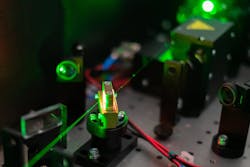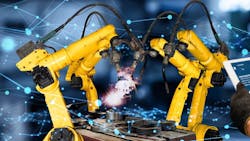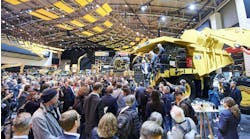Use of artificial intelligence (AI) is increasing in manufacturing and a range of other industries. AI's ability to continually learn and process information enables it to help analyze data and solve problems.
With these capabilities, manufacturers and other users of AI have the potential to improve efficiency and productivity of their operations.
Power & Motion spoke with Murad Kurwa, Vice President, Advanced Manufacturing Engineering at Flex – a global technology, supply chain, and manufacturing solutions provider – about the benefits of AI in manufacturing as well as trends the company sees related to this technology.
*Editor's Note: Questions and responses have been edited for clarity.
Power & Motion (P&M): How are you seeing artificial intelligence (AI) being used within the manufacturing industry?
Murad Kurwa (MK): Several manufacturing processes can benefit from artificial intelligence. When deciding how to deploy AI technologies on the factory floor, it’s important to start with an end goal in mind, and then use the technology to help meet that goal. Some examples include factory line optimization, predictive maintenance, anomaly detection, inventory management and bottleneck prevention.
Based on the end goal, an AI model life cycle can be created by gathering and curating data, selecting the type of AI model you want to use, training the model, determining if the model performs well enough to achieve the final goal, and finally deploying it in production.
In addition, ensuring that the model works and can scale to meet required manufacturing speeds is also important to derive the value out of AI. By constantly learning and improving over time, these programs promote significant progress in quality and efficiency and facilitate more informed and data-driven decisions.
P&M: What benefits can be achieved by using AI within manufacturing operations?
MK: AI can help improve efficiency, enhance quality, and bolster productivity. Take some of the use cases I listed earlier, for instance.
When we think about predictive maintenance, AI solutions can help collect, analyze, and detect shop floor machine issues before they happen. With significant upstream data from connected machines, AI models can indicate that an adverse event might happen before it does, allowing manufacturers to stop potential failures and eliminate downtime.
When you think about anomaly detection, manufacturers can train AI models for quality control by detecting product defects and anomalies, reducing the need for manual inspection, and helping drive product consistency and quality. Anomaly detection can also be applied at the process level, where the AI model can make use of the surfeit of data coming from the manufacturing execution system (MES), machines, and operators to detect process-wide anomalies and avoid any possible downtimes.
Another effective use of AI in manufacturing, outside of operations, is looking at contracts. AI language models look at the contracts, redline, summarize, and detect important points to reduce the overall processing time significantly.
In general, using AI can help people at all levels of the organization make informed, data-driven decisions in real-time that can lead to huge cost and efficiency savings.
P&M: Do you have an example you can share for how you’ve seen AI deployed in an effective manner?
MK: At a few of our Flex locations, we deployed AI to improve the quality inspection process. Traditionally, this was a task done by human operators.
Here is a fitting example of how this type of technology works. On a particular manufacturing line, we had two almost identical capacitors. The only difference between the two components was the valves. This made it incredibly difficult for the human eye to detect anomalies. And if the wrong capacitor was used, the product wouldn’t work properly.
By using vision data and an AI model, our advanced manufacturing technology could see if an operator placed the components in the correct spot and provide feedback to fix any issues in real time. This not only resulted in greater performance and yield but also enabled us to reduce scrap by identifying key issues before a part was sent to another step in the line.
READ MORE: Subjective Quality Testing is Becoming a Thing of the Past
P&M: How, if at all, is Flex working with AI and helping customers to utilize it?
MK: At Flex, we are applying AI to eliminate bottlenecks in the typically labor-intensive and time-consuming printed circuit board assembly (PCBA) testing process.
In one instance, our customer’s end of line PCBA functional test consisted of four stages, with just one stage lasting more than 2 hours to work through the over 50 steps [of which] it was comprised. If failures or anomalies were detected at any step of the process, the device needed to go back to square one to work out the bugs and subsequently restart the entire testing process. This impeded throughput and increased lead time significantly, especially for a failure that occurred late in the process.
That is when we stepped in to analyze each of the test steps' historical data and employ an AI/ML (machine learning) classification model in order to develop a new plan for rearranging and prioritizing them in the most efficient and reliable way. By doing so, we were able to scale down the overall test time by 30%, and 50% in the case of failures.
By providing these insights and optimizations, we deepened our partnership with our customer who will incorporate the product and test design optimizations into their next-generation product.
P&M: How do you foresee the use of AI and its capabilities progressing in the coming years?
MK: Machine connectivity, AI, and other Industry 4.0 technologies have the power to create smart factories and transform operations on every level. AI-based systems will continue learning, getting more intelligent, and identifying more patterns, making the manufacturing process more efficient over time.
The holy grail of AI in manufacturing is to achieve ‘Closed Loop Autonomous Control.’ This basically corresponds to using AI in conjugation with other Industry 4.0 technologies to achieve self-correcting autonomous systems that maximize manufacturing performance in terms of yield, throughput, and quality.
For example, on an automated PCBA line, all the assembly is done by robotics cells, which are all connected to the data lake sending real-time process data. This data is used by an anomaly detection AI model that detects an anomaly in the process and identifies the contributing parameter. This inference is then used by the feedback control loops to correct that parameter in the process (e.g. changing a parameter in a robotic cell) automatically.
This type of advanced self-detecting and correcting system using AI brings the “Point of Detection” closer to the “Point of Origin” and doesn’t let the defects flow through the process. Looking towards the future, this can be achieved using state-of-art Industry 4.0 technologies and certainly AI.
In addition, we will see a widespread use of AI models in non-operational segments of manufacturing such as supply chain optimization and administration.




